Ahhh, binge-reading. Long before people started to bragfess to losing entire weekends to Breaking Bad on Netflix, we were there: supine in our beds or our floors, bunched into the corner of the couch or the comfy chair, a huge stack of single issues or trades allowing us to melt time like it was so much wax.
Just the other day—yesterday, in fact—I found myself with two-thirds of the prerequisites for a binge-reading marathon: I had eight hours of air travel, and I was suffering from a powerhouse of a cold, so my desire and ability to carry on conversations were curtailed. (Having said “two-thirds,” I realize I don’t actually know what that last prerequisite is: a relationship ending? Sustained unemployment? A college semester with an undemanding class load? No idea.) I had the iPad and a ton of comics downloaded to the iPad—wait, maybe that’s the third prerequisite?—and after a certain amount of dithering around, I finally settled on one of my big post-holiday purchases, the entire Max run of Garth Ennis’ The Punisher.
(This turned out stupidly long so let’s throw this behind the jump, eh? It’s what the long-lost primitive people of the Internet used to refer to as a Long Read.)
My goal was to read all sixty issues in one swell foop, but between the cold doing a number on my attention span and the person in the next seat on the last leg of our trip continually striking up conversations with the missus and I—we didn’t mind, he was actually pretty great (and wearing a Green Lantern shirt, to boot)—I only made it a bit more than halfway.
Of course, thirty-six issues of Garth Ennis isn’t just like chain-smoking your way through a bunch of Batman comics: it’s like reading six complete novels, with new characters being introduced, established, and then—because it’s Ennis— violently killed.
And what was especially striking to me was how close they come to reading like six different novels. Back before my fever broke, I thought I’d write about each arc in terms of which type of novel they seemed to reflect (“Mother Russia is the Tom Clancy one; Kitchen Irish is the George V. Higgins one; Barracuda is the Carl Hiaasen one”). But I put a stop to that nonsense long before I sat down to write this post: for one thing, I felt it diminished Ennis’ accomplishments by reducing them to pastiche. (For another, I haven’t actually read anything by Tom Clancy, Carl Hiaasen, or George V. Higgins so I was only coming to come off like a complete asshole that way.) Nonetheless, I thought it’d be worthwhile to at least split them into their respective arcs? So….
In The Beginning (issues #1-6)
Summary: Teaming with Lewis LaRosa, Tom Palmer, and Dean White, Ennis sprints through his opening issue, reintroducing Frank Castle with the most grimly candid origin recap ever published, having Frank then violently murder 40+ people, and for a capper reintroduce old Punisher ally, Micro, as Frank’s seeming nemesis. Before the arc is through, we’re introduced to Nicky Cavella, the mafia guy too ruthless for the Mafia, Nicky’s henchmen Ink and Pittsy, the CIA agents Roth and O’Brien and their boss, Robert Bethell. The Punisher spends a full third of the arc in chains as these characters hunt, antagonize, and kill one another, ending in a final issue shootout that is admirably ghastly.
The Good Stuff: That first issue really is tremendous—a high octane mission statement with Ennis taking the character right where he belongs: using a belt-fed machine gun to blow apart mafia goons. An unstoppable tough guy, Pittsy seems like Ennis’s love letter to Paulie Walnuts, and his fight with Frank in the last issue is perfectly brutal. The last five or six pages of issue #6 are sobering, heartbreaking. Although the title “In The Beginning” seems to allude to Micro’s question of where Frank really became the Punisher (When he saw his family killed? Back in Vietnam? That day philandering neighbor Bob Garrett came over to visit?), I think it’s really about Ennis’ belief in this take on the character: at the end of this arc, we’re really seeing The Punisher for the first time, as Ennis believes we should see him: a being so deep in an antiheroic darkness, it’s impossible to look at the character the way he existed before. (Not that Marvel hasn’t tried a few time since…)
The Bad Stuff: Lewis LaRosa is far too fond of basing his characters on photo references: the few times Nicky Cavella turns into Al Pacino is bad enough, but I think the scenes of Micro offering a new life to Frank are genuinely hurt by LaRosa’s continued insistence on drawing Frank as modern day Clint Eastwood. Roth and O’Brien, the two CIA agents, are standard Ennis shtick characters—O’Brien is a tough chick who’s sexually aroused by The Punisher, Roth is the harried company man who ends up with his balls in a cup (Ennis sure does love his castrated company men!)—better suited to the bear punching Steve Dillon days.
What I Was Going to Compare It To: I dunno, a Stephen Hunter novel, I think? It’s tough, because the thing it mostly reminded me of was Ennis’ other work with the character.
“Kitchen Irish” (issues #7-12)
Summary: A diner in Hell’s Kitchen explodes, and The Punisher and two members of M.I.6 are drawn into a battle between several factions of the neighborhood’s Irish mobs. Before it’s through, we meet a bomber who’s blown off his own face; a potentially incestuous pair of river pirates; Maginty, a black man from Dublin who’s arguably the most violent and sociopathic of the lot; and Napper French, a “Houdini” man who makes dead bodies disappear by cutting them “into so many pieces the cops could never find ’em all.” Art by Leandro Fernandez, colors by Dean White.
The Good Stuff: As you might imagine, Ennis—born in Northern Ireland and resettled in New York City—has some thoughts about the links between the I.R.A., Irish-American crime, and the ribbons of money passing along between the two. The criminals in “Kitchen Irish” are manipulative, violent, and incapable of trust, but Ennis also shows them as victims, easily manipulated by not just their greed, but their own romantic beliefs about Ireland and themselves. Those scenes are standouts. The art by Leandro Fernandez is strong, with Dean White saturating the blacks such that the art reminded me of Eduardo Risso’s in more than a few places.
The Bad Stuff: Well, The Punisher isn’t in it especially much and his reasons for being in the story at all are pretty slight—he not only survives the bombing of the diner, he’s also recruited to help out his buddy from M.I. 6. There are so many characters in the story, some of them get short shrift and while one plot swerve gets properly hinted at in advance, other hints about the real shooter of the M.I. 6 agent’s dad go nowhere. Although I think it’s supposed to be like one of those Golgo 13 stories where Golgo 13 barely appears, Kitchen Irish feels a lot more like an old screenplay or abandoned project repurposed to work as a Punisher story.
What I Was Going To Compare It To: The Treasure of the Sierra Madre, by way of George V. Higgins. It also reminded me a lot of Martin McDonagh’s In Bruges.
Mother Russia (issues #13-18)
Summary: By contrast to Kitchen Irish, Mother Russia moves Frank front and center as he gets recruited by Nick Fury for an impossible job, which entails a HALO jump into Russia, infiltrating a nuclear bunker, and trying to save a six-year old girl wanted by both Russia and the U.S. for the one-of-a-kind designer virus in her veins. Art by Doug Braithwaite, Bill Reinhold, and Raul Treviño.
The Good Stuff: As mentioned above, Castle is front and center in this one, and each issue has at least one standout scene of violent action, perfect for the airbound, cold-suffering monster lurking inside us all. (This is the third of three arcs to feature a scene of the Punisher using a high-caliber machine gun to turn masses of attackers into paint.) And seeing the situation turn more impossible for Frank at every turn (the Delta Force agent assigned to accompany him has a secret agenda, the bunker has no way out, and the Russians, like Nicky in the first arc, have a way to get past Frank’s seemingly impenetrable defense). And the climax is a kick, especially knowing how much Ennis is a fan of the Judge Dredd Apocalypse War storyline.
The Bad Stuff: Braithwaite and Reinhold’s art is serviceable, but even with Treviño doing some stellar coloring, the art feels flat and repetitive, especially the Punisher’s “face like a mangled thumb” and everybody else’s “I’m holding a tiny wedge of lemon between my two pursed lips” expression. Nick Fury pops up here and in order to distinguish him from Frank, Ennis ups the amount of time Fury spends talking about sex, and reminding everyone he pays women to sleep with him.
Because Ennis knows you can only spend so much time hanging out with an unstoppable killing machine whose only traits are icy, self-righteous anger and the desire to kill even more people than he’s just killed, we get a lot of scenes of bald portly General Zakharov trying to determine if the Americans are responsible for the siege on the nuclear bunker, and a lot of scenes of American generals hatching a crazy plan to keep the Russians from figuring out if the Americans are responsible. All of these scenes work at underlining the importance of the situation, but, like the art, they ultimately feel a bit samey.
And when I first read this arc, I thought the Russian’s special weapon (a tiny dude who knows savate, smuggled into the base via one of the cannon fodder) was kind of dumb; it definitely reminded me of a beat from an action movie I can’t recall now. Rereading it, I realized there wasn’t enough of the tiny dude who knows savate. My memory of this arc had somehow turned into two issues of him savate-ing the shit out of Frank and the Delta Forces guy, and it’s really only six or seven pages at best.
But don’t be fooled by The Bad Stuff section being longer than The Good Stuff section (it’s the Jeff Lester equivalent of a guy with a high caliber machine gun turning masses of attackers into paint). Mother Russia is a really strong satisfying read.
What I Was Going To Compare It To: A Tom Clancy novel, although really it’s more of a Tony Scott movie treatment of a Tom Clancy novel. But that’s a good thing.
Up is Down and Black is White (issues #19-24)
Summary: Ennis brings back Mafia madman Nicky Cavella—with his wacky unstoppable henchman this time being Pittsy’s sister, Tessa—with a plan to draw out and take down the Punisher: by defacing the dead bodies of the Castle family. The return of Roth and O’Brien, and O’Brien’s ex, Rawlins (although he popped up behind the scenes of Mother Russia as well) as well as artist Leandro Fernandez (inked this time by Scott Hanna and inked by Dan Brown) marks this story as a sequel to “In The Beginning.”
The Good Stuff: With Frank driven into a cold killing rage by the defacement of his family’s corpses, Ennis gets a chance to really show us the darkness of Castle’s psyche: the ending of one issue is him shooting up a drug den while ruminating on a dream he has of literally murdering the entire world, and the start of the next is him having that dream, looking scarily sated in an endless landscape of corpses. Nicky Cavella gets an origin story (a bummer, since Ennis usually only gives his villains an origin story right before he kills them) that paints him as Frank’s opposite number: like Frank, Nicky sees his entire family killed before his eyes…but only because he’s the only who did the killing. If not for an unforeseen interruption, Nicky’s plan would’ve actually worked.
The Bad Stuff: Ennis’ female characters are usually problematic for me. Although I gave O’Brien, the “scary gets me hot” CIA agent from the first arc, a pass for just being a tonal misstep, her reappearance here (with substantially the same kink and substantially the same character), suggests that Ennis is so steeped in the tradition of men’s heroic fiction, he can’t tell when he’s creating a truly terrible female character. O’Brien and Tessa (and, in the flashback, Nicky’s Auntie Mo), the only women in this story, are completely motivated by their sexuality and there’s something more than a little off about that.
As for the art, Fernandez can draw some truly expressive faces and it’s obvious he’s far more comfortable with the kind of violence Ennis wants to show (and he does a thing with panel width that almost duplicates a panning out that’s really neat), but Hanna lets the linework lie flat and you can see Dan Brown doing all kinds of cheats with the color to give the work depth. (There’s a full page shot of The Punisher driving that, once you look past all the dazzling flares and refracted colors, looks like The Punisher is actually driving one of those foreshortened beep-beep cars you see little kids on at a amusement parks.)
What I Was Going to Compare It To: First and foremost, it feels like an Ennis story, for better and worse. Although the final scene of the Punisher leading a character into the woods to shoot him reminded me of Miller’s Crossing, but, really, how can you not have a scene of one character leading another into the woods to shoot him and not think of Miller’s Crossing?
The Slavers (issues #25-30):
The Summary: A woman with a gun and a painful past leads Frank to track down the Moldovan slavers who have pressed women into sex work in America. Art is again by Leandro Fernandez with colors by Dan Brown, but Scott Koblish is on inks this time which is good because he brings more variation to the linework. Although, again, it’s really Brown who deserves a shout-out or three, as he does a lot of more subtle variations within each page’s palette to give the art its depth.
The Good Stuff: Sex trafficking is scary, and even scarier is how easily it can escape detection. About a third of The Slavers is Frank trying to figure out how he can get close enough to the people at the top since they can totally disappear at the first sign of any trouble.
Also pretty great: there’s Tiberiu Bulat, a crazy old badass who is a million times more of a mean motherfucker than you could ever imagine (as much a staple of Ennis’ Punisher Max work as the high-caliber machine gun scene)…but the real scary characters are his son, Cristu, and their partner, Vera, who represent not just the banality of evil but its efficiency. When it becomes obvious Tiberiu is too proud and too blood simple to just sit on the sidelines, Cristu realizes he has no choice but to put a hit out on his own father. And in a series filled with painful lingering deaths, the one involving the shatterproof window is probably the most satisfying Ennis has come up with to date.
The Bad Stuff: To keep the plates spinning, Ennis cooks up a strong B-story involving a crooked cop’s publicity campaign to shame the NYPD into hunting The Punisher (making Frank’s attempts to discreetly infiltrate the slave ring even harder). Russ Parker and Marcie Miller, two of the cops who are the public face of the campaign, don’t like how they’re being used and investigate what’s happening behind the scenes. Every issue has at least one scene of Miller and Parker, including a scene of them being brutally beaten in the locker rooms by seven other officers, but they never really emerge as anything like depthful characters, and their thematic ties to the other storyline—ultimately, just as Cristu realizes he is in a bad partnership with his father, Marcie comes to realize Russ will likely sell out their investigation to progress his career—is painfully slight and undercooked. In fact, like Kitchen Irish, there are arguably too many underdeveloped characters here: I was struck by the window scene when it was originally published but on the reread it has much less heft because the character involved is barely a part of the story. (Seriously, I thought maybe I’d somehow skipped an issue by the time it came along.) Tiberiu pretty much stole the story to the story’s detriment. Oh, and don’t even get me started on the social worker who helps Frank and then spends a lot of time weeping by the side of a toilet for doing so. Like I said, I usually find Ennis’ female characters problematic.
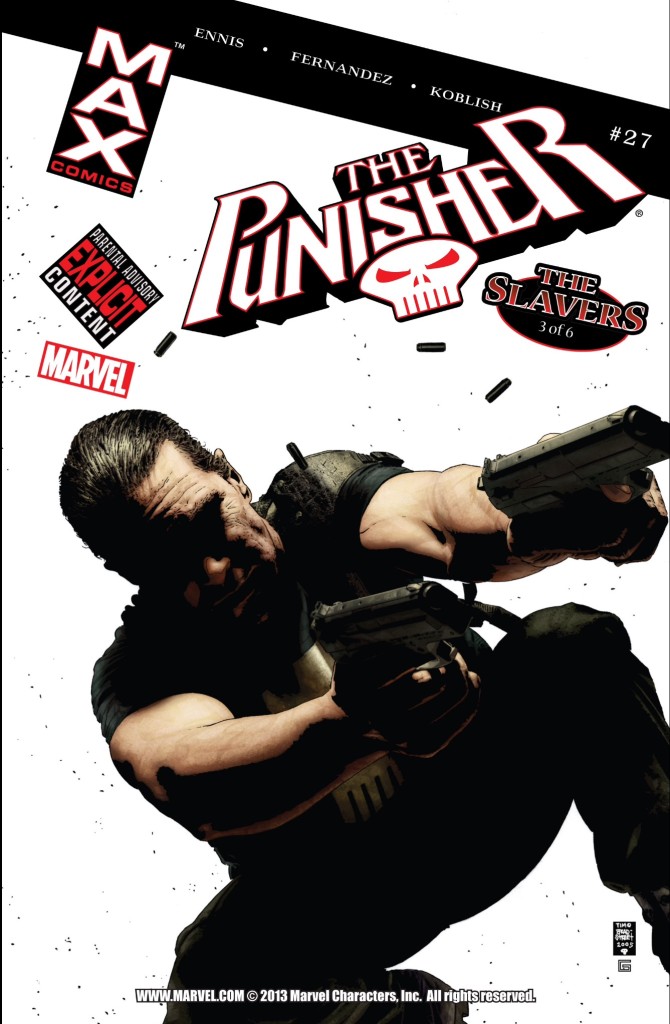 Finally, now is probably the right time to confess I don’t really like Tim Bradstreet’s covers which are a hallmark for the entirety of Ennis’ run. I get the sense behind having them—Bradstreet’s mixture of photo and illustration are theoretically a good match for the near-reality of Ennis’ stories, and they give the books a thematic consistency (and, when they were first being published, made the books stand out on the stands). But I find his work at best limited, and at worst lazy, and the gritty reality of The Slavers only underlines it. The story deserves better than the laughable “The Punisher shoots guns while dodging his own falling logo” cover of issue #27.
Finally, now is probably the right time to confess I don’t really like Tim Bradstreet’s covers which are a hallmark for the entirety of Ennis’ run. I get the sense behind having them—Bradstreet’s mixture of photo and illustration are theoretically a good match for the near-reality of Ennis’ stories, and they give the books a thematic consistency (and, when they were first being published, made the books stand out on the stands). But I find his work at best limited, and at worst lazy, and the gritty reality of The Slavers only underlines it. The story deserves better than the laughable “The Punisher shoots guns while dodging his own falling logo” cover of issue #27.
What I Was Going to Compare It To: The police stuff, which doesn’t really pan out, feels like prime James Ellroy, with everybody trying to work an angle. I wanna say The Slavers part of the storyline reminds me of Andrew Vachss, but I can’t because I haven’t read any Vachss. He always gets a ton of praise from guys I respect, like Joe Lansdale, but I can never seem to make any headway with his work for some reason. By contrast, The Slavers is a pretty good read, despite all the sections where we’re clearly supposed to be outraged. The Slavers is supposed to be a mean little piece of exploitation propaganda, and on that level it succeeds.
Barracuda (issues #31-36)
The Summary: Following the trail of an influx of high grade cocaine, Frank gets embroiled in the shady doings of Dynaco, a corporation about to make big money by forcing power blackouts in Florida. As he tracks the corruption to its source, he meets the corporation’s cleaner, the one and only Barracuda, a man as jovial in his commitment to murder and brutality as Frank is dour. The art is by the amazing Goran Parlov, with colors by Guila Brusco.
The Good Stuff: Oh, man. As long as you can give a pass to the gloriously offensive Barracuda—the type of scary black guy arguably only other black people should be allowed to create—it’s almost all good stuff. Ennis is working the ground closest to his previous Punisher run with Steve Dillon here, where the satire and the dark humor give the violence a shiny pop exuberance. (There have to be a ton of essays on how Ennis is essentially the perfect distillation of the 2000 A.D. esthetic, right?) And he’s aided to an immeasurable degree by the outstanding chops of Goran Parlov, working in an Alex Toth vein of using pacing and design to give everything a perfectly balance weight: the resulting “cartooniness” only adds to the pop outrageousness.
As for Barracuda, it’s undoubtedly due to my own place of privilege, but I more than give him a pass: I love the guy. To go full fanboy for a second, he is The Joker to The Punisher’s Batman, except it could be argued that instead of being the embodiment of death, Barracuda is the full and unfettered embodiment of life, reveling in the joyful vagaries of existence, especially as it pertains to the important stuff: death, pain, and betrayal. We see tremendous amounts of all three in Barracuda, and the story opens and closes on the same image: the living feeding on the dead, after civilization’s thin veneer has been entirely cut away.
The Bad Stuff: Well, as I more or less admit above, the good stuff is the bad stuff here, and unfortunately this damn cold has left me without the strength to really dig into perhaps where all these words were leading: if Ennis’ Punisher is more craft than art, than I think I’m right to clutch my pearls and worry about problematic portrayals of women, of people of color, of crime (though on that last point, Ennis is far more cued in than most on how crime is the product of corruption, greed, and cowardice on the part of those who benefit most from society).
Because a piece of craft can, and arguably should, be tempered to the needs of the marketplace, and if enough people in that marketplace demand their entertainment be conscious enough to suit progressive ends, then it should be and we shouldn’t be so upset about the dilution of artistic expression or freedom of speech or some such.
On the other hand, if Ennis’ Punisher is a work of art—a genuine expression of conviction and belief, a catalog of fears and hopes that dare to look under or beyond those of the unacknowledged everyday—then it’s easier to give the book the latitude to play with images of people of color or women’s sexuality (or, as in the memorable case of a sex scene between the two cheating lovers followed immediately by Barracuda lurking out their door waggling a crazily huge machete, both). There’s an end being served, and that end is foreshadowed in the opening and the closing of Barracuda: Hell awaits, but Hell is no more than Heaven with the nail shadow chipped off, and both are really just life, blindly consuming until its finally time, in the end, to be consumed in turn.

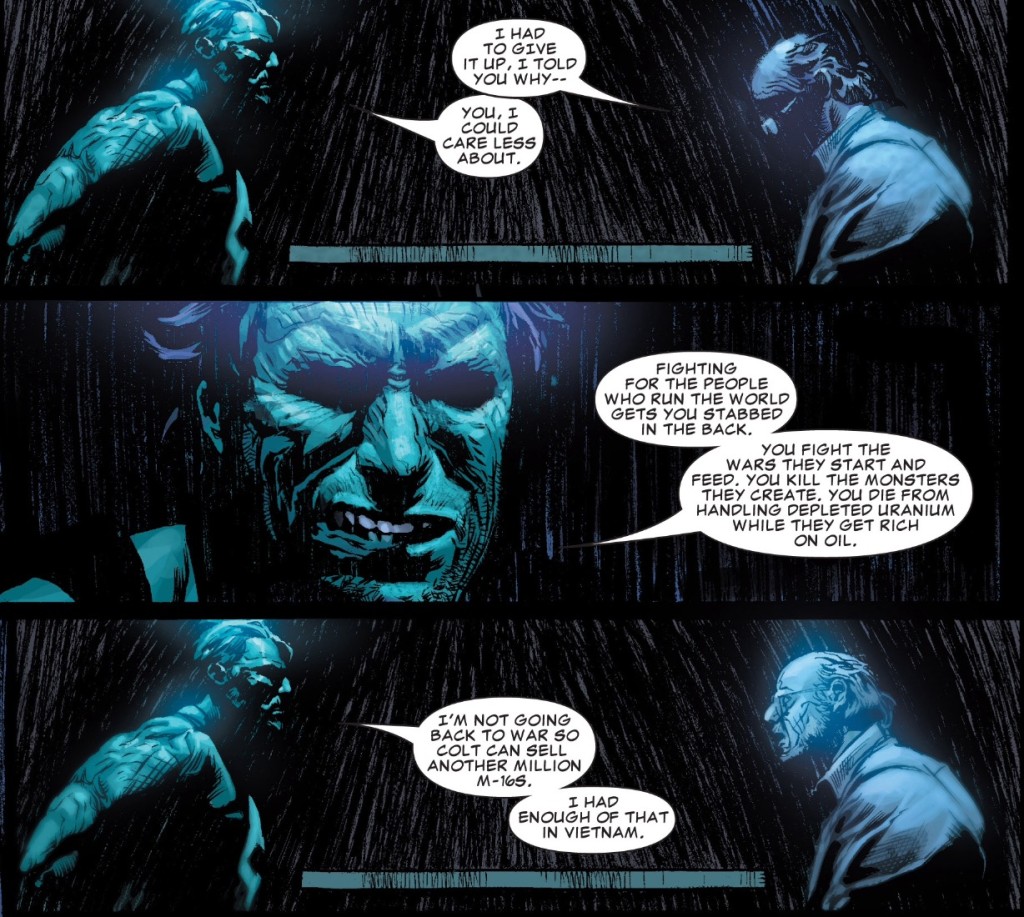

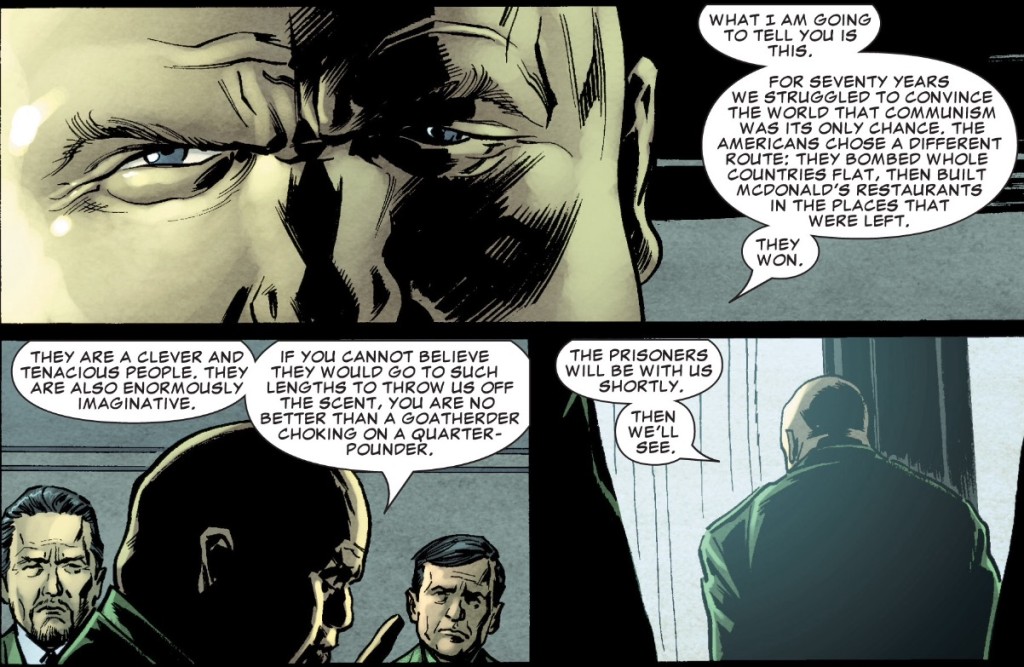
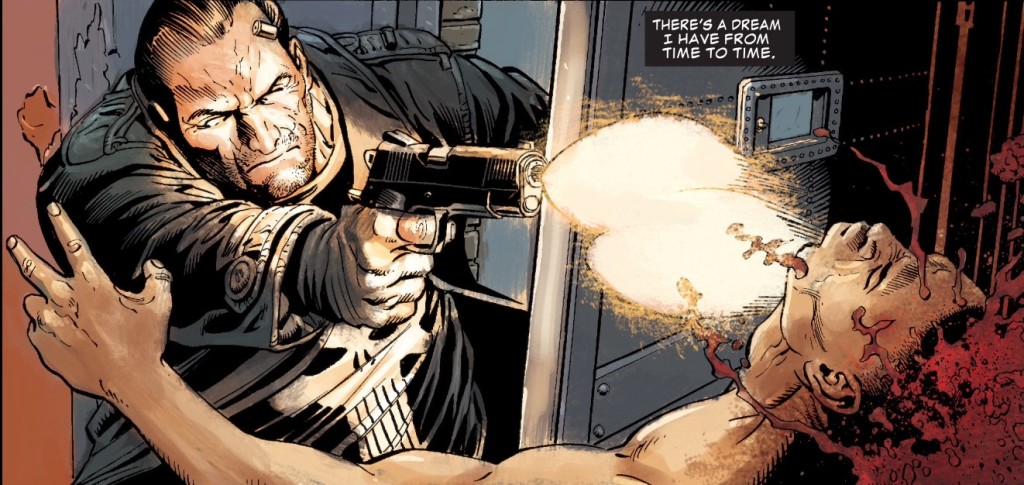
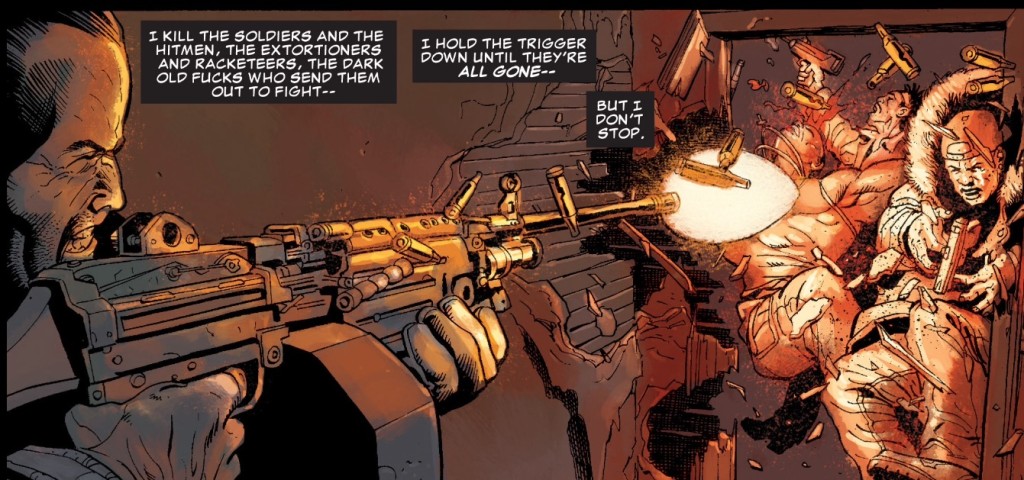
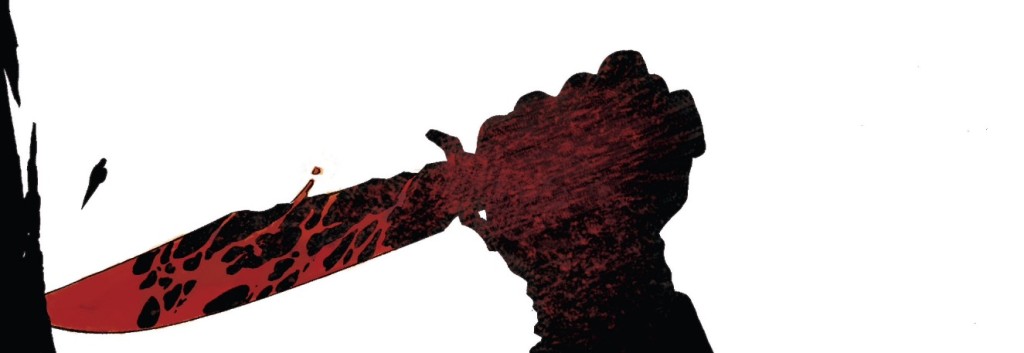
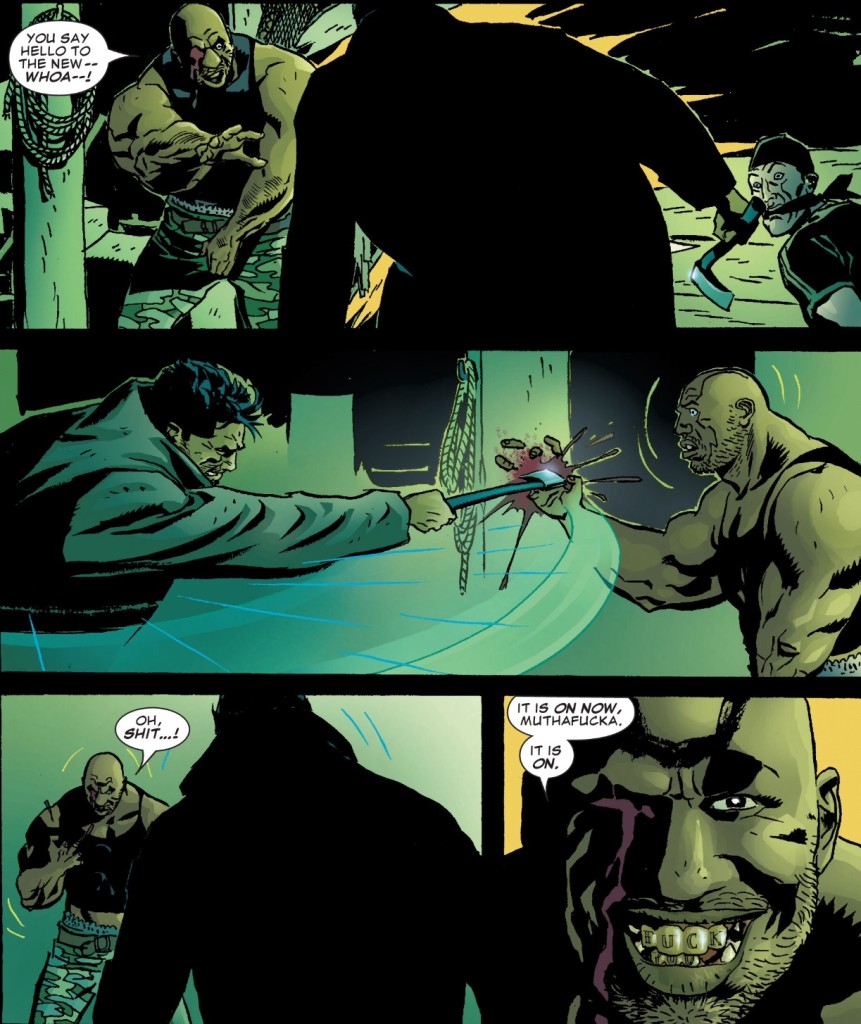


Oh. Man. This is possibly one of my favorite comic runs of all time, and I love that you’re writing about it. Please tell me that you’re gonna finish it, because there’s still some great stuff worth digging into here.
Random thoughts: wasn’t Vera Tiberiu’s daughter? I seem to think that, and it made it ultra-horrifying that she would be complicit in everything, considering how horrible it all was.
Also, considering your tastes, you really should dig into some George V. Higgins. Friends of Eddie Coyle, in particular, is a really great book.
I feel sort of like Barracuda’s a parody of the super-gregarious, scarily-capable-killer black man stereotype that pops up every once in a while (Omar in The Wire, Michael Clarke Duncan in The Whole Nine Yards, Ving Rhames in nearly anything from Mission Impossible onward). He’s so incredibly over-the-top that I almost think he has to be.
Of course, Ennis has a miraculous ability to simultaneously lampoon tropes while simultaneously buying into them (The Boys was basically a great 90-issue study in this, as well as his 5-issue Phantom Eagle mini), and it’s something that keeps me coming back to his writing again and again.
One of the things I love in this run, also, is how distinct Frank’s voice is. There’s a dryness there that occasionally veers into this bleak humor (“Must have eaten his spinach” is a particular stand-out to me), and it’s one of the…I dunno, purer takes on Frank that I’ve read. His monotone rings true, the way he’s clearly cracking jokes just to keep himself amused. Also, that great part of Frank talking about the kick of a rifle relaxing him.
That’s such a good point about Frank’s voice. I came *this* close to using the “must have eaten his spinach” panel since it amused me so much.
I also think that idea of lampooning and buying into tropes—again, such a 2000 A.D. thing to me that so few can really do outside that mag (or inside it, sometimes)—is dead-on.
Thanks for the comments, Matt!
I didn’t think I’d ever enjoy a Punisher run, but I generally really liked Ennis’ run on the MAX version of The Punisher (never really got into the Marvel Knights run). Jason Aaron’s follow up was pretty good in parts, but I found it not as consistant.
If you keep reading/writing about these I thought I’d mention that while Ennis’ main run was 60 issues long, you’re forgetting the spinoffs! Clearly essential for the complete Ennis Punisher Max experience.
Born: (4 issues), Ennis and Darick Robertson. Frank Castle in Vietnam.
These three are collected as Punisher: From First to Last
Punisher: The Tyger (1 issue), Ennis and John Severin. Frank Castle is a little kid.
Punisher: The Cell (1 issue), Ennis and Lewis LaRosa. Frank Castle is in prison.
The Punisher: The End (1 issue), Ennis and Richard Corben. Even I’d forgotten this until I was looking up details on the other stuff. Also, remember when Marvel was doing all of those “The End” Series?
Punisher Presents: Barracuda (5 issues), Ennis and Goran Parlov. You can probably guess!
Thanks for listing these, MM!
I consider Punisher: The Tyger essential to this run (and intend on re-reading it as a coda after issue 60), but didn’t bother with The Cell or The End.
And the Barracuda mini I remember reading and enjoying—really wish it’d been part of that Comixology sale. Interestingly, Punisher: Born, if I remember correctly. I had such *huge* hopes for it and remember feeling pretty let down by it. I wonder if it would work better for me now?
Ennis is one of the few writers of war stories who can celebrate the heroism of individual soldiers without celebrating war itself. Ennis is acutely aware that war is ultimately a racket, a conflict manufactured by elites to further their interests regardless of who gets in the way. Against the backdrop of war as a man-made disaster, the individuals, be they John Custer and Spaceman, or the Night Witches from Battlefields, or Mother’s Milk from the Boys, are the ones actually doing the right thing and making the hard decisions at cost to themselves.
And with the Punisher under Ennis we don’t even have that, because his Frank is a complete monster who just happens to point his guns at people who deserve it.
This is such a perfect little distillation, Neil, thanks for it. I had a friend talk about how much they love this run and mentioned how they felt that even though Ennis didn’t like Frank Castle at all, he wrote him better than anyone.
I was going to ask why he thought Ennis didn’t like Castle but you totally gave me the answer I needed here.